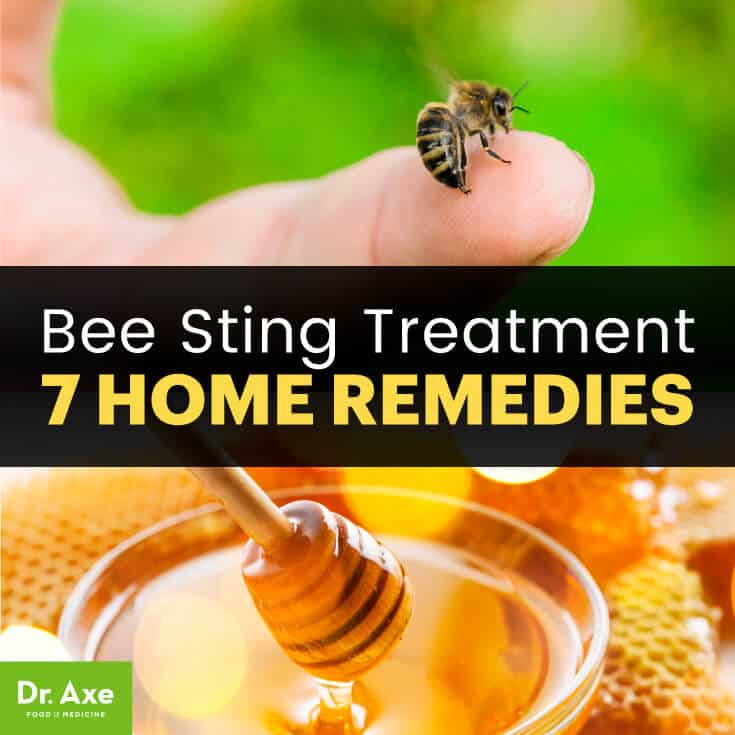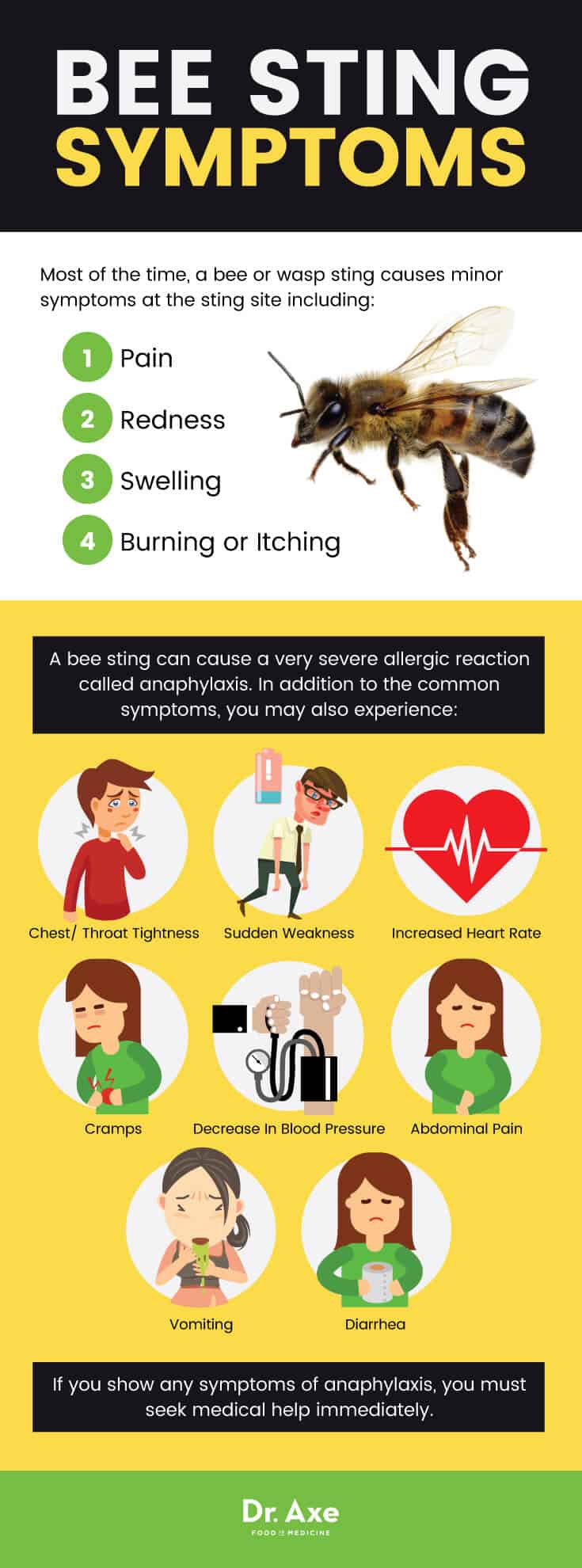
As the weather warms up and people spend more time outdoors, it’s a very smart idea to have some bee sting treatment options on hand. As you probably already know, a bee sting is a sting from any type of bee, while a wasp sting comes from a wasp. For most people, bee stings are an annoying and painful occurrence that can be treated without medical intervention. According to the University of California Integrated Pest Management Program, “Only a very limited portion of the population — one to two people out of 1,000 — is allergic or hypersensitive to bee or wasp stings.” (1)
If you already know that you are allergic to bee stings or have been stung multiple times, then you should not use a natural bee sting treatment. Bee sting home remedies are definitely not meant for anyone who experiences severe reactions to a bee sting. These reactions might include breathing difficulty or throat tightness and other indications of a severe allergic response. However, according to National Capital Poison Control, the most common “normal” reaction to a sting from a bee, wasp, yellow jacket or hornet is not too serious. It usually involves some pain, swelling and itching only at the area where you got stung. (2)
I hope you won’t have to use any bee sting treatment I’m about to discuss. But just in case you or a loved one do get stung by one of those buzzing honey makers, you’ll know just what to do after reading this article.
Bee Sting Interesting Facts
- There are around 20,000 different species of bees in the world today.
- Only female bees can sting thanks to the venom they store in a sac attached to their stinger, which is part of the female bee’s reproductive system. (3)
- Some kinds of bees, like Africanized honeybees, are more likely than are other bees to swarm and sting in a group.
- You are more likely to get a bee sting if your work or hobbies involve spending time outdoors or if you live somewhere that bees are especially active or with beehives nearby. (4)
- Approximately 3% of people stung by bees and wasps experience an allergic reaction. Up to 0.8% of bee sting victims experience the severe, life-threatening allergic reaction called anaphylaxis. (5)
- Some kinds of bees actually die after stinging because their stingers (attached to their abdomen) have little hooks on them and when they go to fly away after stinging someone, part of their abdomens are torn away. (6)

Common Bee Sting Symptoms
When a bee stings you, it leaves a behind a venomous toxin that can cause unpleasant symptoms. It’s not uncommon to be stung by a bee. Most of the time the sting will probably come from a honey bee. Yellow jackets, which are actually wasps, not bees, are the leading cause of insect sting allergic reactions in the United States. (7)
According to the The National Capital Poison Control:
All symptoms of an ‘ordinary’ sting are at the sting site itself. Expected effects are pain, swelling, redness, and itching. All effects are at that specific spot. Even if the area is still red, swollen, itchy, and painful the next day — it’s an expected reaction, not an allergic reaction. (8)
Most of the time, a bee or wasp sting causes minor symptoms at the sting site including: (9)
- Pain
- Redness
- Swelling
- Burning or itching
Bee Sting Treatment: 7 Bee Sting Remedies
For ordinary bee stings that do not cause an allergic reaction, experts agree that a home bee sting treatment is enough. If you do not have multiple bee stings or an allergic reaction, home remedies for bee stings are all you need for an ordinary bee sting, according to sources like the Mayo Clinic. (10)
Before using any natural bee sting remedy or wasp sting remedy, Poison Control advises that you do two things: (11)
- Remove the stinger: When you get stung by a bee, the first thing you should do is determine if the stinger is still present in your skin (you’re looking for a small black dot at the sting site). If it is, then you should scrape it out with an object that is not sharp, like a finger nail or the edge of a credit card. If may seem like a good idea, but do not use tweezers or fingers to pull out a stinger because this only pushes more venom into the skin.
- Sanitize the area: Once the stinger is out, you should cleanse the sting site well with soap and water.
At this point, conventional treatment of stings often includes applying a cortisone cream or an antihistamine cream. For severe itching many people also take diphenhydramine (brand names like Benadryl®). If you would rather try a natural bee sting treatment, then here are some of the best and most effective options:
1. Baking Soda + Water
Baking soda uses and remedies are pretty endless. In fact, baking soda is even part of a natural bees sting treatment. Rather than using a conventional steroid or antihistamine cream, Poison Control also instructs that you can apply a paste of good old baking soda and water. (12) You definitely don’t want to forget this simplistic, yet highly effective, bee sting treatment, which also works as a wasp sting remedy.
2. Ice
One of the simplest, yet most effective, remedies for a bee or wasp sting is to apply an ice pack to the area where you got stung. The CDC also recommends ice as part of basic bee or wasp sting management. The ice will help with both inflammation as well as itching. It will also help draw blood to the sting site for optimal healing. (13)
3. Elevation
The arms and legs can be common sting sites. If you are stung on your arm or leg, elevate that affected limb. Elevation will allow gravity to help fluid leave the swollen area where you were stung. (14)
4. Apple Cider Vinegar
Another great home bee sting treatment that you likely already have on hand is apple cider vinegar. By applying apple cider vinegar to the area where you got stung, it can help to neutralize bee venom and therefore calm unwanted bee sting symptoms. An easy way to apply apple cider vinegar to a bee sting is to saturate the non-sticky, absorbent pad of a bandage and put the bandage over the sting. This way, that padded area comes in contact with the area where the stinger went into your skin. You can also soak a clean bit of cloth in apple cider vinegar and apply it to the area for 15 to 20 minutes at a time. (15)
5. Honey
So a honeybee may have been the insect behind your throbbing sting, but what a honeybee makes can also help to quell the inflammation and itch. It can also help to prevent infection. I’m talking about honey and I recommend raw honey in particular for its higher anti-inflammatory enzyme content. Raw honey contains 22 amino acids, 27 minerals and 5,000 enzymes. When honey is applied to a sting site or wound, the enzyme glucose oxidase actually produces hydrogen peroxide. This creates an inhospitable environment for bacteria. (16) You can apply a small amount of high quality honey to the sting area, cover it with a loose bandage and leave it on for an hour or less. You can do this several times per day as needed.
6. Activated Charcoal
You can mix activated charcoal powder with water or oil to create a paste and apply it as a bee sting home remedy (also a wasp sting remedy). The activated charcoal helps to draw out any leftover venom and calm bee sting and wasp sting symptoms. (17)
7. Witch Hazel
Pimples, mosquito bites, bee stings, wasp stings…the list goes on and on when it comes to all the ways witch hazel can calm inflammatory skin issues. Witch hazel is an astringent made from the leaves and bark of the witch hazel plant. Simply apply witch hazel directly to the sting site as needed. (18)

How to Make a Bee Sting Home Remedy
Ingredients:
- 1 capsule of activated charcoal
- ½ tablespoon of coconut oil
Directions:
- Pour the contents of one activated charcoal capsule into a small bowl and add the coconut oil, mixing well.
- Dab the mixture onto the affected area.
- Reapply every 30 minutes until itching and discomfort subside.
You may want to cover the sting area with a bandage after you apply the mixture since charcoal stains whatever it touches very easily. You can also try my DIY Healing Poultice Remedy, which I remember my grandma using on my bee stings as a kid.
Bee Sting Possible Side Effects and Caution
A bee sting can cause a very severe allergic reaction called anaphylaxis. Anaphylaxis often initially reveals itself as severe itching of the eyes or face. Within minutes, more serious symptoms can develop including: (19)
- Swelling, which can cause problems with swallowing and breathing
- Hives and swelling
- Chest tightness and a feeling of tightness in the throat
- Sudden weakness
- Increased heart rate
- Decrease in blood pressure
- Cramps
- Abdominal pain
- Vomiting
- Diarrhea
If you show any symptoms of anaphylaxis, you must seek medical help immediately. Anaphylaxis can quickly cause shock, unconsciousness and even death if not treated fast enough.
According to Mayo Clinic, most bee stings do not require a trip to the emergency room or a visit to your doctor. However, in more serious cases, you definitely need to seek immediate medical care. If you’re having a serious reaction to a bee sting and just one or two symptoms that suggest anaphylaxis, then call 911. If you have previously been prescribed an emergency epinephrine autoinjector (like an EpiPen), use it immediately as directed. People who experience a severe allergic reaction to a bee sting have a 30 to 60 percent chance of anaphylaxis the next time they’re stung. Adults also tend to have more severe reactions than children. Adults are more likely to die of anaphylaxis than children are. (20)
Seek prompt medical care if bees have swarmed you and stung you multiple times. Multiple stings can be a medical emergency in children, older adults, and people who have heart or breathing problems. Wasp or bee stings in the mouth or nose, even in people not known to be allergic to bee stings, also require emergency medical care since stings in these areas can lead to swelling that can interfere with breathing.
Bee stings can itch, but avoid scratching since that can cause infection. If your mild bee sting symptoms don’t resolve within a few days or you’ve begun to have other allergic response symptoms, then see your doctor right away.
You can also call Poison Control at 1-800-222-1222 any time if you have questions about how to handle a sting and whether or not you or someone you know is having an allergic reaction.
Final Thoughts
Bee stings are certainly not pleasant and for some people they can even be life-threatening. As long as someone does not experience a serious allergic reaction, then doing a bee sting treatment in the comfort of your own home can be all that you need. Bee stings may not be fun, but at least a natural bee sting treatment is easy and cost effective.
According to the CDC, there are also some ways you can prevent stings in the first place, including: (21)
- Avoid spending time around flowering plants and definitely stay far away from known bee hives or wasp nests.
- Don’t use perfumed soaps, shampoos, conditioners, lotions and deodorants, especially ones with synthetic scents.
- If you know you’re going to spend extended time outdoors, it’s also smart not to wear perfume or cologne.
- Wear smooth-finished, light colored clothing.
- Avoid consuming bananas outdoors since they can attract bees.
- Wear clothing that covers as much of the body as possible (without overheating of course).
- If a single stinging insect is flying near you, it’s very important to remain relaxed and still.
- Don’t swat at a stinging insect since swatting may cause it to sting.
Read Next: Top 5 Home Remedies for Mosquito Bites
If you feel like you could use some more in depth information on essential oils, Dr. Josh Axe is hosting a free webinar going over, in great detail, uses and tips for using essential oils. Click below to learn more.
